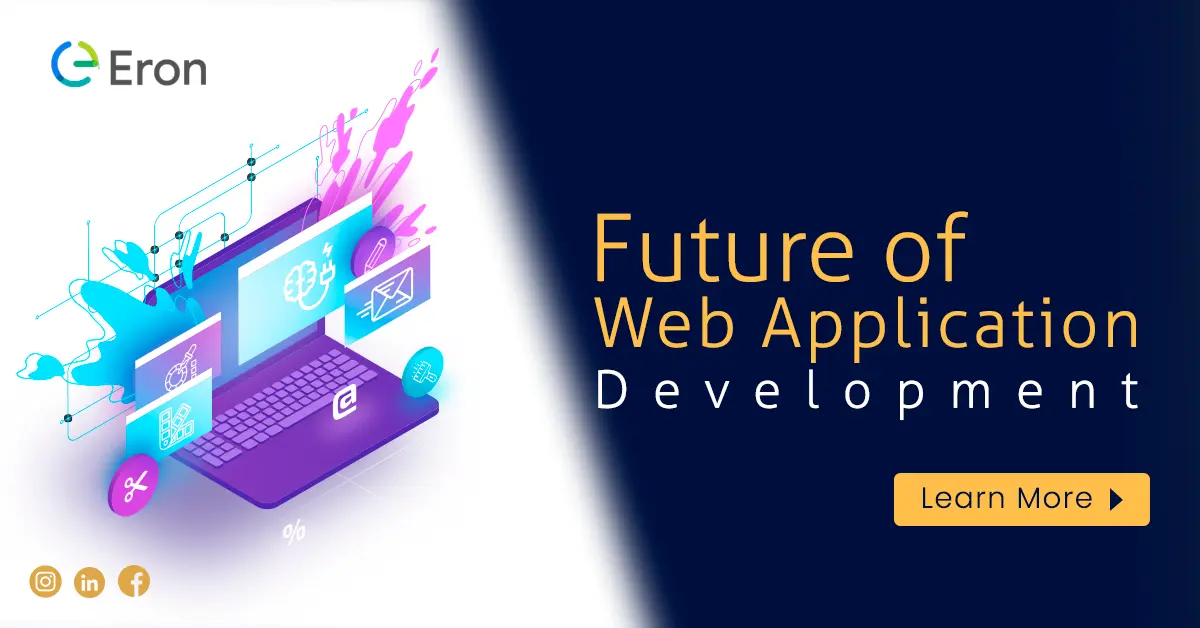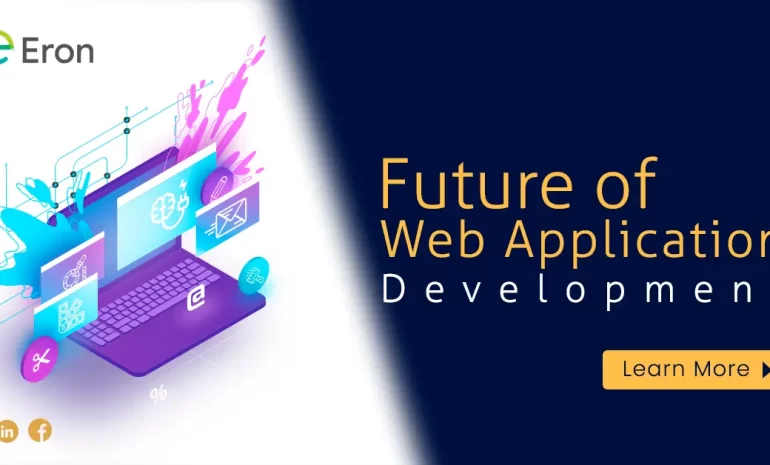Do you know that almost 90 percent of global internet users view the web through mobile? This fast pace in trending towards mobile-friendly and easily accessible web applications demonstrates precisely how fast web technology progresses.
The world of development for web applications is perpetually changing, with an influx of new ideas developing every day.
Being kept abreast of these changing trends is no longer optional but rather a requirement among businesses and developers.
Web application development spans all the ways of simple websites to dynamic and interactive applications running our lives every day.
With the advancement of technology, business and developers need to keep abreast of what is in the future that could change and shape how to design, build, and use web applications.
This blog will discuss the near future of web application development, indicating all the trends and technologies that are expected to guide this constantly moving domain.
From AI integration to low-code platforms, everything is covered here to keep you abreast.
Table of Contents
The Current State of Web Application Development Practice
Current Trends Shaping Web Development
Today, characteristics of web applications are defined by certain trends. For example, mobile responsiveness and PWAs, a certain kind of mix between websites and mobile apps. Flexibility and scalability in the form of cloud-based solutions now form the backbone of modern web applications.
Also Read: Best 6 Web Development Best Practices You need to Know
Why Should You Keep Up?
With today’s competitive digital world, businesses and developers cannot afford to lag behind. They can create responsive, efficient, and user-friendly applications only if they embrace the current trends.
Evolving Innovations that are Shaping Future
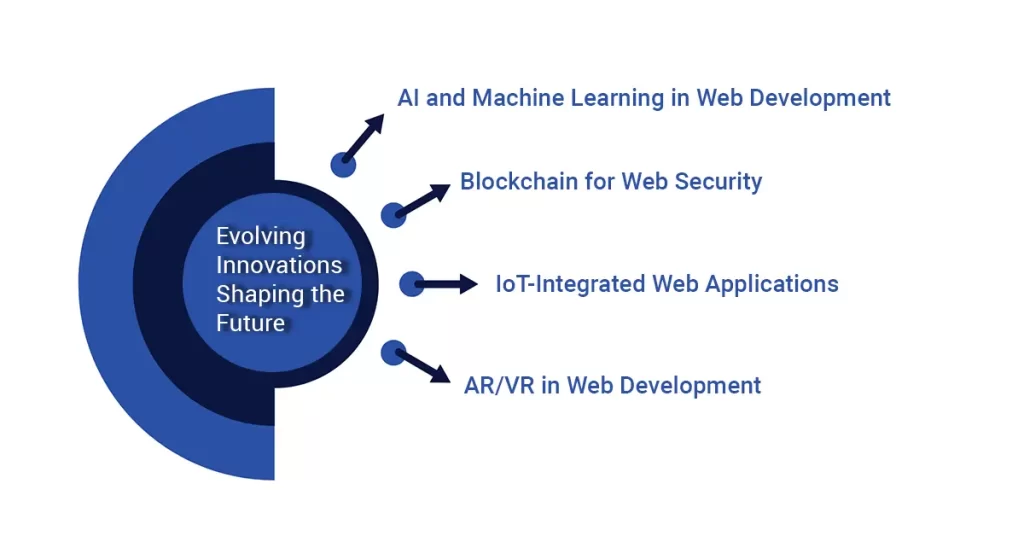
AI and Machine Learning in Web Development
AI and ML are going to revolutionize the Future of Web Application Development. From AI-powered chatbots that improve customer service to recommendation engines that personalize content, these technologies enable web applications to offer smarter, more customized experiences.
Block chain for Web Security
The increasing security threats nowadays have brought up block chain as a promising tool for developing secure, decentralized applications. Block chains can prevent unwanted access to data and hence promise web applications dealing with sensitive information.
IoT-Integrated Web Applications
The IoT allows devices to converse with one another, and share data easily. Incorporation of web applications in healthcare and logistics can improve data collection, better operational efficiency, and new ways of interacting with users.
AR/VR in Web Development
Augmented reality and virtual reality break into web applications and provide the web site with new immersive user-friendliness that could revolutionize several sectors, such as e-commerce and real estate. Users can virtually try on clothes or tour houses.
Trend Changing UX in Web Applications
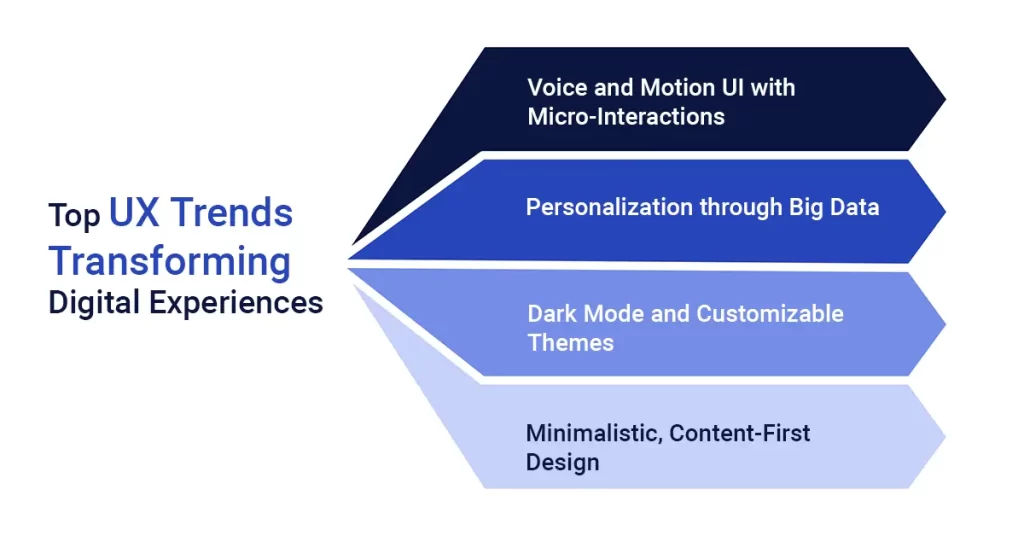
Voice Search and Voice UI
Voice search has also transformed web applications through being in devices that are so vocalized. Users may operate hand-free on applications in applications that make use of the voice UI. More friendly and easy experience for anyone around the world.
Motion UI and Micro-Interactions
Animations and micro-interactions can provide advanced interactivity on a web application level, such as highlighting subtle buttons or the swipe animation. They improve user interaction and the overall user experience, so applications are felt more ‘alive’ and responsive.
Personalization through Big Data
Big Data allows web applications to deliver more personal experiences by analyzing user behavior and preferences. Web applications can personalize content, recommendations, and features based on the needs of individual users using data-driven insights.
Dark Mode and Customizable Themes
Both dark mode and customizable themes reduce visual strain while still enabling users to change the UI to their taste, which helps in increasing comfort and engagement.
Minimalistic, Content-First Design
Clean, content-focused layouts with plenty of white space and simple navigation improve readability and usability to help users focus on what matters most.
The Rise of Low-Code/No-Code Development Platforms
Empowering Citizen Developers
Low-code and no-code platforms are revolutionizing web application development by making it accessible to citizen developers who do not have a formal coding background.
The platforms allow small businesses, startups, and even non-technical teams to build and deploy applications faster, lessening their dependence on traditional developers.
This democratization of development enables companies to finish projects faster and save on costs, particularly for those that require rapid iteration.
The Role of Automation in Development
Automation also plays a key role, with AI-based tools that automate the coding process. These tools can perform repetitive actions, flag errors, and suggest code snippets, allowing professional developers to work more efficiently on complex aspects of the projects.
Developers can reduce timelines, enhance productivity, and improve the accuracy of applications by automating these tasks. Together, low-code/no-code and automation are transforming the development landscape, making it more accessible, efficient, and agile for modern needs.
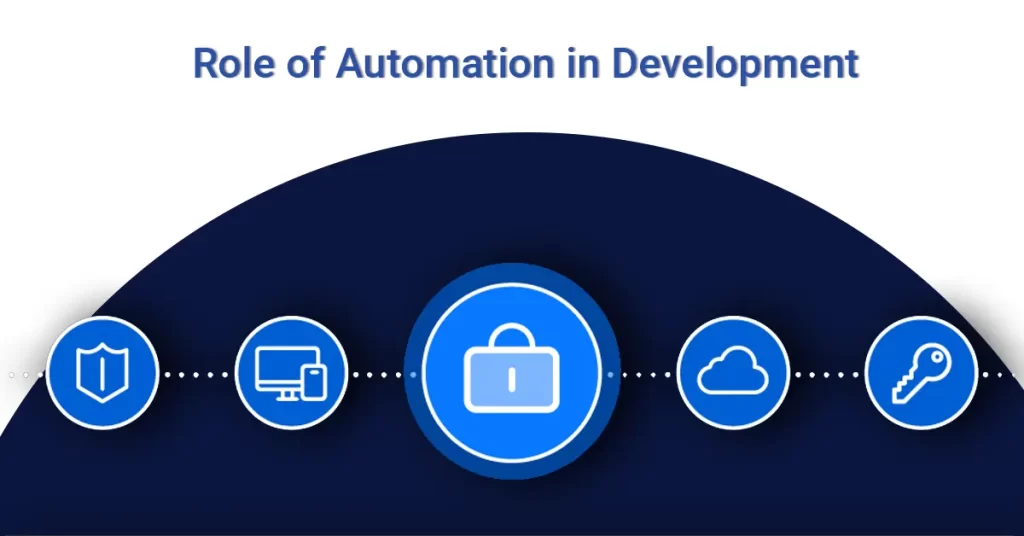
Web Application Architecture and Scalability Trends
Micro services and Server less Architecture
This breaks the application into many, independent, modular parts and thus makes updating, scaling, and management much more fluid. Each operates in isolation, problems in one do not affect the rest of the system, it’s much more flexible and resilient.
Serverless architecture advances the ability to scale on resources by entirely eliminating server management because resources are automatically managed and allocated by the cloud provider.
It actually removes some cost from infrastructure while promoting high availability for such applications as this design is perfect for any kind of application that would need to scale in and out very quickly.
The Role of Cloud and Edge Computing
Cloud computing offers scalable storage and computing power, where applications can scale up and down with usage demands without on-site hardware.
Edge computing, on the other hand, processes data closer to the user, reducing latency and improving speed for real-time applications.
Together, cloud and edge computing provide a scalable, fast, and efficient foundation for modern web applications, enhancing both performance and user experience.
Trends in Web Application Architecture and Scalability
Micro services and Server less Architecture
Applications in micro services architecture break into independent, modular components and are easier to update, scale, and manage. Each component runs independently, problems in one area will not affect the whole system, making the architecture more flexible and resilient.
The server-less architecture optimizes further scalability by removing management over servers; the cloud provider automatically adjusts resources based on demand.
This means it will minimize infrastructure costs while still ensuring high availability. It is perfect for applications that require scaling quickly.
The Role of Cloud and Edge Computing
It offers scalable storage and computing power, where applications adapt usage demands without requiring on-site hardware
On the other hand, edge computing processes data closer to the user, hence reducing latency and increasing speed for real-time applications.
Altogether, cloud and edge computing create a scalable, fast, and efficient foundation for modern web applications that will enhance performance and user experience.
The Impact of 5G on Web Application Development
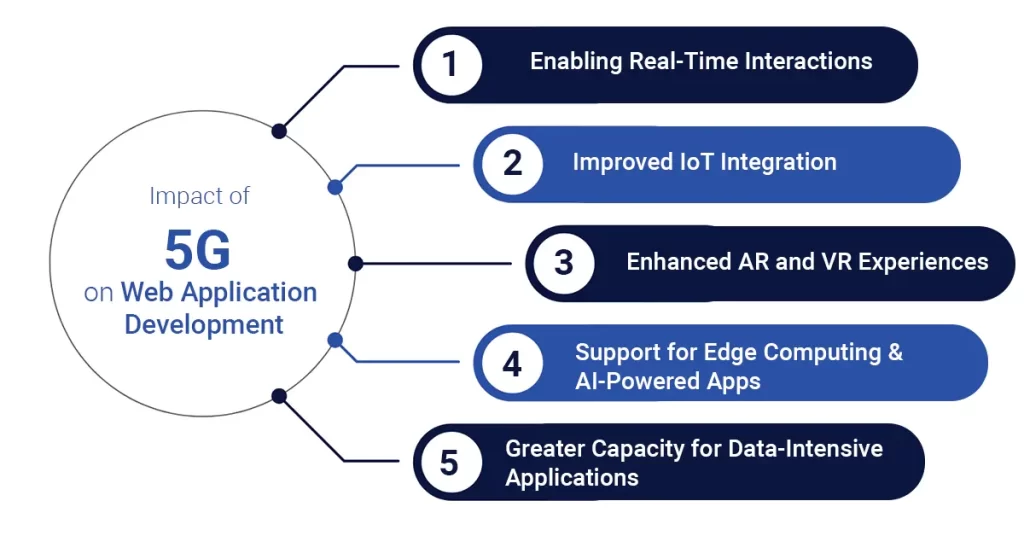
Enabling Real-Time Interactions
5G’s low latency allows for near-instantaneous communication, making it ideal for applications that rely on real-time interactions, such as gaming, live streaming, and video conferencing.
Developers can build more immersive, responsive apps that support live updates and real-time data exchanges with ease.
Improved IoT Integration
With 5G, web applications can handle a larger number of connected devices at higher speeds, which is crucial for IoT-powered apps.
This enables more seamless integration with IoT devices, expanding possibilities for sectors like smart homes, healthcare, and logistics, where real-time data processing is essential.
Enhanced AR and VR Experiences
The higher bandwidth and speed of 5G make it possible to bring augmented reality (AR) and virtual reality (VR) experiences into web applications more effectively.
This can transform user experiences in industries like ecommerce, real estate, and education by enabling rich, interactive, and visually dynamic features with minimal lag.
Supporting Edge Computing and AI-Powered Apps
5G’s high-speed connectivity complements edge computing, where data is processed closer to the source.
This synergy allows AI-powered applications to deliver instant insights, paving the way for real-time recommendations, predictive analytics, and improved user personalization on web platforms.
Greater Capacity for Data-Intensive Applications
5G provides the necessary infrastructure for data-intensive applications, like those handling high-resolution video, complex animations, or large-scale data visualization.
This means developers can push the boundaries of what is possible, creating applications that would have previously been too heavy for mobile or low-bandwidth environments.
The Role of Cyber security in Future Web Development
As cyber threats evolve, so do future applications of the web, being developed with built-in advanced security measures.
Advanced application-layer security protocols will help ensure that unauthorized access to applications is thwarted, and robust technologies such as MFA and zero-trust architecture have a lot to contribute.
Gaining concerns about the data’s confidentiality have seen a surge in adoption of privacy-oriented design practices among developers.
Future web applications will have to comply with stricter, overarching data protection regulations that reflect responsible and transparent treatment of user data.
Future of Web Application Development
Universal Web Apps
The future will be that of universal web apps that work well on all platforms and devices, thanks to the increased popularity of PWAs and hybrid applications.
This would make development easier, cost-effective, and more accessible.
AI-Powered Web Development Tools
AI is expected to even more largely take over in web development. Developers are going to get assistance, from coding and debugging, to testing, through AI-based tools.
AI tools will allow faster development, fewer errors, and highly efficient development.
Web3 and Decentralized Apps
Decentralized applications are driven by Web3 technologies, they should increase in size, proposing a new method of storing and processing data.
It may be one of the steps toward safer web applications as it eliminates server dependency in centralized systems.
Conclusion
Web application development is advancing rapidly with emerging technologies like AI, block chain, IoT, AR/VR, and 5G, each adding new capabilities.
Low-code platforms speed up app creation, edge computing enhances real-time processing, cyber security grows increasingly critical, and decentralized applications are on the rise.
To stay competitive in this digital landscape, developers and businesses must embrace these trends to build secure, efficient, and user-focused applications.
Eron Techno Solutions is here to help you leverage these innovations in your projects. Contact us to create future-ready web applications tailored to your needs!
FAQs of Web Application Development
1. What is the difference between a website and a web application?
A website is typically a collection of static or dynamic web pages designed to provide information. A web application, on the other hand, is an interactive platform that performs specific tasks or functions, such as online banking or project management tools, often requiring user authentication and complex data interactions.
2. What is web application development?
Web application development involves creating software applications that run on web servers and can be accessed via web browsers. It encompasses both front-end (client-side) and back-end (server-side) development.
3. How does 5G technology impact web application development?
5G technology enhances web application performance through ultra-fast data transfer rates and low latency, enabling richer, more complex applications and seamless mobile experiences.
4. What are low-code/no-code platforms?
Low-code and no-code platforms allow users to create applications with minimal coding skills. They provide visual development tools that speed up the development process and make it accessible to non-developers.
5. Where can I learn more about web application development?
You can explore online courses, webinars, and industry blogs that focus on web development trends, best practices, and emerging technologies to enhance your knowledge and skills.
